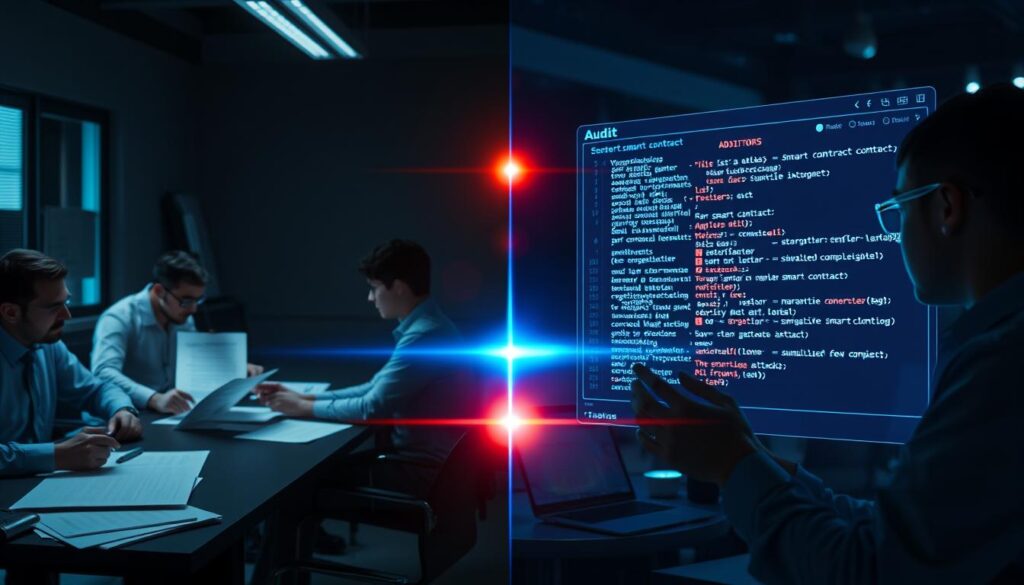Now Reading: Expert Machine learning smart contract audit Services
- 01
Expert Machine learning smart contract audit Services
Expert Machine learning smart contract audit Services

Digital agreements on blockchain networks operate with permanent consequences. Once deployed, these self-executing programs cannot be changed or reversed. This creates a critical need for thorough security review before launch.
The scale of deployment is staggering. Ethereum alone sees over half a million new agreements every month. Traditional manual review methods struggle to keep pace with this explosive growth.
Minor coding errors can lead to catastrophic financial losses. The “code is law” principle means there’s no safety net after deployment. This makes pre-launch security assessment absolutely essential.
Advanced technologies are emerging to address these challenges. Artificial intelligence systems can analyze code patterns at unprecedented speeds. They complement human expertise by handling repetitive tasks and identifying subtle vulnerabilities.
This guide explores how intelligent automation transforms security verification. We’ll examine practical applications for developers and project managers. The focus is on making comprehensive protection accessible to projects of all sizes.
Key Takeaways
- Smart contracts are immutable once deployed, making pre-launch security critical
- Traditional manual auditing cannot handle the volume of new contracts
- Advanced technologies scale security processes while maintaining accuracy
- AI systems complement human auditors rather than replacing them
- Automation handles repetitive tasks and identifies subtle patterns
- Financial consequences of coding errors can be catastrophic
- Intelligent verification makes comprehensive protection more accessible
Understanding the Importance of Smart Contract Audits
Trust is the cornerstone of any successful blockchain project, and it is built upon a foundation of rigorous security practices. These self-executing programs handle immense value and sensitive data, making a thorough examination before launch non-negotiable.
Why Security Matters in Blockchain Applications
Blockchain networks are inherently transparent and adversarial. Malicious actors constantly probe applications for weaknesses. Identifying and fixing these flaws before deployment is the only way to prevent devastating financial losses.
High-profile incidents have shown the real-world impact of inadequate reviews. Exploits have led to millions in losses and severe reputational damage. A robust security process protects both the project and its users from these threats.
Consequences of Undetected Vulnerabilities
When weaknesses go unnoticed, the results can be permanent. Financial losses are often irreversible due to the nature of distributed ledgers. Beyond money, user confidence and brand reputation can be shattered.
Common risks include logic errors and access control issues. These potential vulnerabilities threaten the very integrity of an application. A comprehensive review mitigates these risks and ensures the code functions as intended under all conditions.
Ultimately, strong security is vital for the entire ecosystem’s health. Major breaches create a negative perception that hinders broader adoption. Proactive protection is an investment in long-term viability.
The Evolution of Machine Learning in Smart Contract Security
The approach to ensuring code safety on distributed ledgers has progressed through multiple technological generations. Each phase introduced new capabilities while addressing limitations of previous methods.
From Manual Reviews to AI-Powered Tools
Early security assessments relied entirely on human expertise. Professionals examined code line by line for potential issues. This thorough process created significant bottlenecks for developers.
The first automation wave brought static analysis capabilities. These tools scanned code without execution, identifying known vulnerability patterns quickly. They dramatically reduced the time required for initial reviews.
Dynamic testing methods emerged next, simulating program behavior under various conditions. This approach uncovered runtime issues that static analysis might miss. Formal verification then added mathematical proof techniques.
Today’s advanced systems combine multiple analytical approaches. They offer comprehensive coverage through layered security strategies. This evolution represents continuous improvement in protection methodologies.
Modern solutions handle the explosive growth of blockchain development effectively. They provide developers with efficient tools for robust security practices. The journey from manual processes to intelligent automation continues to transform safety standards.
Machine Learning Smart Contract Audit: The New Standard
The blockchain security landscape is undergoing a fundamental transformation. AI-powered examination of digital agreements is rapidly becoming the expected norm, not an experimental option.
This new paradigm combines automated analysis with human expertise. It creates a comprehensive and efficient security review process.
Traditional methods struggled with the sheer volume of new code. The modern approach tackles this scalability challenge head-on. It ensures robust protection can keep pace with rapid development.
Security has evolved to require multi-layered strategies. Advanced algorithms work alongside experienced professionals. This collaboration provides a thorough vulnerability assessment.
The goal is optimization, not replacement. Repetitive tasks and pattern-matching are delegated to intelligent systems. This allows experts to focus on complex business logic.
| Aspect | Traditional Standard | New AI-Powered Standard |
|---|---|---|
| Primary Focus | Manual, line-by-line code review | Hybrid human and algorithmic analysis |
| Scalability | Limited by human resource availability | Highly scalable, handles large codebases efficiently |
| Key Advantage | Deep contextual understanding | Speed, continuous monitoring, and pattern recognition |
Leading security platforms now integrate these capabilities. This makes advanced protection accessible to projects of all sizes.
Adopting this standard offers a competitive edge. Benefits include faster deployment, reduced costs, and ongoing risk monitoring. As digital agreements grow more complex, this powerful analytical approach is essential for maintaining adequate security.
Traditional vs. Modern Audit Methods
A significant gap exists between the capabilities of time-honored security checks and contemporary automated systems. Each approach offers distinct advantages and faces specific limitations.
Understanding this difference is crucial for selecting the right combination of techniques for a project.
Manual Audits Versus Automated Analysis
Traditional examination relies on human experts reviewing code line by line. This process is thorough and understands complex business logic.
However, it is slow, expensive, and difficult to scale. These constraints often make it impractical for smaller teams or rapid development cycles.
Automated analysis provides a powerful alternative. These tools can scan vast amounts of code quickly.
They identify known risky patterns with speed that manual processes cannot match. The key advantage is scalability and consistency.

Static Analysis, Dynamic Testing, and Formal Verification
Modern techniques offer a layered defense. Static analysis examines code without executing it, looking for dangerous structures.
Dynamic testing, or fuzzing, runs the code with countless inputs to find runtime errors. This catches issues static checks might miss.
Formal verification uses mathematical proofs to guarantee correctness. It offers the highest assurance but requires significant expertise and time.
| Method | Primary Function | Best For | Limitation |
|---|---|---|---|
| Static Analysis | Scans code for known vulnerability patterns | Rapid initial screening | Can produce false positives |
| Dynamic Testing | Executes code with varied inputs to find runtime bugs | Uncovering hidden execution flaws | May not cover all possible code paths |
| Formal Verification | Mathematically proves code behaves as specified | High-stakes financial applications | Complex and resource-intensive |
No single method is perfect. A combined approach using multiple techniques provides the most robust security for digital agreements. The choice depends on project needs, risk tolerance, and available resources.
Leveraging AI for Rapid Vulnerability Detection
Modern security challenges require detection capabilities that operate at digital speed. Traditional methods struggle to keep pace with today’s fast development cycles.
Advanced systems excel at identifying security flaws in minutes rather than days. This speed advantage transforms how teams approach protection.
Catching Reentrancy and Overflow Bugs
These analytical tools specialize in finding common but dangerous coding errors. Reentrancy attacks occur when external calls interfere with state updates.
Integer overflow and underflow issues corrupt numerical calculations. Systems trained on thousands of exploits recognize subtle variations of these patterns.
Early identification prevents catastrophic financial losses. Fixing problems before deployment is significantly cheaper and safer.
Continuous Real-Time Feedback During Development
Integration into development workflows provides immediate security assessments. Each code commit triggers automatic scanning for potential vulnerabilities.
This real-time approach prevents technical debt accumulation. Multiple security flaws compounding over time become increasingly difficult to resolve.
The automation scales across massive projects with numerous dependencies. Consistent focus maintains protection standards that manual processes cannot match.
These advanced security tools also monitor live deployments around the clock. They identify suspicious patterns and potential exploitation attempts as they occur.
Key Machine Learning Techniques for Smart Contract Audits
Modern security systems employ several core analytical methods to ensure code integrity. These approaches work together to provide a deep and comprehensive review.
They examine programs from different angles. This multi-layered strategy catches a wider range of potential issues.
Static Code Analysis and Anomaly Detection
Enhanced static examination reviews source code without running it. Algorithms are trained on vast datasets of vulnerable and secure code.
This training allows them to recognize dangerous patterns and common mistakes. They can even spot novel variations of known security flaws.
Anomaly detection establishes a baseline for normal code behavior. It then flags any significant deviations from this pattern.
This is crucial for identifying unusual logic or potential malicious insertions. It helps catch problems that might otherwise go unnoticed.
Natural Language Processing for Code Comprehension
Natural Language Processing gives systems the ability to understand code intent. It analyzes elements like function names, comments, and documentation.
The technology verifies that the written description matches the actual implementation. This catches dangerous discrepancies between what is promised and what the code does.
This comprehensive approach combines structural, behavioral, and intentional analysis. The synergy between these techniques creates a robust safety net for digital agreements.
Graph Neural Networks and RAG in Audit Processes
Cutting-edge technologies are transforming vulnerability detection by analyzing complex relationships within applications. These advanced systems go beyond traditional methods to uncover hidden risks.
Understanding Graph-Based Code Analysis
Graph Neural Networks represent programs as interconnected graphs. Functions, variables, and dependencies become nodes and links in these structures.
This approach excels at identifying issues that emerge from interactions between multiple components. It detects recursive call patterns and cross-application vulnerabilities effectively.
Enhancing Results with Retrieval-Augmented Generation
Retrieval-Augmented Generation systems combine language models with external databases. They reference past security reviews and known exploits during analysis.
This contextual approach improves accuracy and provides better explanations for findings. The system grounds its conclusions in established security patterns.
| Analysis Method | Primary Strength | Best Use Case |
|---|---|---|
| Graph Neural Networks | Detects complex interaction vulnerabilities | Multi-component applications |
| Retrieval-Augmented Generation | Contextual understanding with historical data | Novel or complex security scenarios |
| Behavioral Simulation | Identifies runtime anomalies | Performance and gas optimization |
These advanced techniques represent the future of comprehensive security assessment. They provide deeper insights than traditional methods alone.
Benefits of AI-Powered Smart Contract Audits
AI-powered examination delivers measurable advantages that transform security economics. These systems provide comprehensive protection while optimizing resource allocation across development cycles.
Enhanced accuracy stems from consistent pattern recognition across entire codebases. Unlike manual reviews, automated tools maintain peak performance without fatigue or oversight. This consistency ensures reliable security assessments.

The speed advantage enables rapid iteration during development. Teams receive feedback within minutes of code commits rather than waiting weeks. This acceleration supports agile development methodologies effectively.
Automation handles repetitive analysis tasks with precision. Human experts can then focus on complex business logic and strategic considerations. This division of labor maximizes both efficiency and effectiveness.
Continuous monitoring extends protection beyond initial reviews. Systems operate 24/7 with immediate alerts for suspicious activity. Real-time response minimizes exposure windows significantly.
Cost reductions reach up to 90% compared to traditional methods. Labor and time savings make enterprise-grade security accessible to projects of all sizes. These economic benefits democratize comprehensive protection.
The combined advantages create a compelling value proposition. Organizations gain robust security while optimizing their development budgets. This transformative approach represents the new standard for code safety.
Integrating AI into CI/CD Pipelines for Smart Contracts
Continuous integration and deployment pipelines offer a powerful platform for embedding proactive security measures. This integration moves protection from a final gate to an ongoing practice.
Every code push can trigger an automated scan. This immediate feedback loop is crucial for modern development teams.
Automating Security Checks on Code Pushes
Automation within these pipelines scans every pull request. It provides a security assessment before human code review begins.
This continuous validation identifies problems the moment they are introduced. It prevents issues from accumulating until a late-stage review.
Developers receive actionable feedback instantly. They can fix vulnerabilities while the code context is still fresh in their minds.
This approach significantly reduces remediation costs. It also empowers the development team to write more secure code from the start.
| Aspect | Traditional Late-Stage Review | Integrated Pipeline Review |
|---|---|---|
| Timing of Checks | Single point, pre-deployment | Continuous, on every code commit |
| Feedback Speed | Days or weeks | Minutes |
| Remediation Cost | High (context lost) | Low (immediate context) |
| Developer Impact | Disruptive, separate process | Seamless, part of workflow |
Configurable security gates can block merges that fail quality thresholds. This ensures baseline security requirements are always met.
The entire process creates a detailed audit trail. It provides transparency for stakeholders and supports compliance needs.
Best Practices for Machine Learning Smart Contract Audits
Achieving optimal code safety requires a balanced partnership between technological tools and expert evaluation. This collaborative approach maximizes strengths while minimizing individual limitations.

Human and Machine Collaboration
Automated systems excel at rapid pattern recognition across large codebases. They consistently identify known vulnerability types with impressive speed. However, these tools have significant blind spots.
Human auditors provide essential contextual understanding that algorithms cannot match. They validate business logic and assess economic models effectively. This combination creates a comprehensive security process.
Treat automated findings as initial assessments rather than final determinations. Every flagged issue requires human verification before action. This prevents both false positives and dangerous oversights.
Regular Updates and Continuous Improvement
Security tools require frequent updates to remain effective. New vulnerability patterns and attack techniques emerge constantly. Regular model retraining ensures detection capabilities stay current.
Establish feedback loops where audit findings improve future analyses. This creates a self-enhancing system that grows smarter over time. Developers benefit from progressively better security assessments.
Clear workflows define how teams triage and prioritize findings. This ensures efficient use of both automated tools and human expertise. The result is a robust, evolving defense strategy.
Real-Life Case Studies in AI-Assisted Smart Contract Audits
Organizations across multiple industries are achieving remarkable results by integrating intelligent analysis into their security workflows. These real-world implementations demonstrate measurable improvements in efficiency and protection.
Financial Sector Implementation
A major banking institution transformed its verification process using advanced tools. The system analyzed thousands of agreements in hours instead of weeks.
This approach delivered both speed and accuracy improvements. The bank now identifies potential issues before deployment.
Healthcare Industry Application
One healthcare provider implemented automated compliance monitoring for patient data systems. The technology scans transactions in real-time.
This proactive approach prevents data breaches and maintains regulatory standards. Patient trust remains strong with continuous protection.
Supply Chain Management Example
A leading logistics company adopted anomaly detection for complex multi-party agreements. The system identifies suspicious patterns across interconnected projects.
This implementation significantly reduced fraud cases. Operational efficiency improved throughout the supply network.
These diverse examples show how intelligent analysis delivers value across sectors. Each project demonstrates unique benefits tailored to specific industry needs.
Overcoming Challenges in AI-Driven Audit Methods
The implementation of intelligent security systems encounters several practical challenges that demand strategic solutions. While these tools excel at pattern recognition, they face limitations in specific areas that require human expertise.
Addressing Business Logic Flaws
Automated systems struggle with complex business logic issues. They cannot evaluate whether financial models or economic structures function as intended.
These tools lack understanding of protocol-specific behaviors and game theory concepts. Human reviewers must validate that the code implements the correct business rules.

Dealing with Obfuscated Code
Deliberately complex or misleading code presents significant challenges. Automated analysis may generate excessive false positives or miss hidden vulnerabilities.
Obfuscation techniques can overwhelm pattern recognition systems. This makes it difficult to distinguish genuine security threats from intentional complexity.
| Challenge Type | Primary Issue | Recommended Mitigation |
|---|---|---|
| Business Logic | Cannot evaluate economic models or protocol intent | Hybrid approach with expert human review |
| Novel Exploits | Misses zero-day threats not in training data | Continuous threat intelligence updates |
| Cross-Protocol Complexity | Struggles with multi-system interactions | Specialized analysis for external dependencies |
| Code Obfuscation | Confused by deliberately misleading structures | Multi-layered analysis with manual verification |
Understanding these limitations helps teams design effective security processes. The goal is complementary collaboration between automated tools and human expertise.
Continuous Monitoring and Automated Risk Scoring
Security protection doesn’t end when code goes live on the blockchain. Advanced systems provide 24/7 surveillance of operational agreements. This ongoing vigilance addresses emerging threats that develop over time.
New vulnerabilities appear as interaction patterns evolve and external dependencies change. Continuous monitoring analyzes transaction flows and state modifications in real-time. It detects anomalous behavior that might indicate exploitation attempts.
Automated risk scoring evaluates detected issues based on multiple factors. These include severity, exploitability, and potential financial impact. This prioritization helps developers address the most critical risks first.
The system creates valuable feedback loops where operational data informs future assessments. Security postures adapt dynamically as threat landscapes evolve. Real-time alerting enables immediate response to suspicious activities.
This approach transforms security from a one-time checkpoint into an ongoing practice. Monitoring results provide intelligence for improving both specific agreements and broader development practices. The continuous nature acknowledges that true protection requires constant attention.
Future Trends in AI and Smart Contract Security
The next generation of security verification is evolving toward predictive capabilities that anticipate risks before they materialize. This forward-looking approach represents a fundamental shift in how we protect digital agreements.
Industry experts are developing systems that forecast potential issues by analyzing historical patterns. These advancements will transform security from reactive detection to proactive prevention.
Advancements in Predictive Analytics
Predictive systems analyze vast datasets to identify emerging threat patterns before exploitation occurs. They examine code interactions across multiple blockchain platforms.
This technology helps developers address vulnerabilities during early development stages. It significantly reduces the window of opportunity for malicious actors.
Standards and Cross-Industry Collaboration
The industry is moving toward standardized assessment frameworks that ensure consistent quality. These standards will help auditors deliver reliable results across different platforms.
Increased collaboration among developers, security researchers, and regulatory bodies accelerates threat intelligence sharing. This collective effort elevates protection standards throughout the ecosystem.
| Aspect | Current Approach | Future Direction |
|---|---|---|
| Detection Method | Reactive vulnerability identification | Proactive risk forecasting |
| Industry Standards | Varied assessment methodologies | Unified security frameworks |
| Collaboration Level | Limited information sharing | Cross-platform intelligence networks |
| Tool Integration | Standalone security applications | Integrated ecosystem protection |
These emerging trends, detailed in comprehensive security analysis, will shape the next decade of blockchain protection. The future landscape combines advanced analytical tools with human expertise for comprehensive coverage.
Developing Robust AI Models for Smart Contract Auditing
Creating sophisticated detection capabilities begins with comprehensive data gathering and systematic processing. This foundation determines the effectiveness of the entire security assessment system.
Data Collection and Preprocessing Techniques
Effective model development starts with diverse datasets. These include both vulnerable and secure examples from various blockchain platforms.
Preprocessing transforms raw code into standardized formats. This step removes irrelevant information and prepares materials for analysis. The quality of this preparation directly impacts learning outcomes.
Model Training and Fine-Tuning Best Practices
Training involves selecting appropriate algorithms for specific security tasks. Different approaches work best for pattern recognition versus anomaly detection.
Fine-tuning optimizes performance by adjusting parameters. This reduces false positives and improves accuracy. Continuous feedback from experienced auditors helps refine the system.
| Processing Stage | Primary Purpose | Key Challenges |
|---|---|---|
| Data Collection | Gather diverse code examples | Ensuring dataset balance and relevance |
| Preprocessing | Standardize code formats | Maintaining semantic meaning during transformation |
| Model Training | Teach pattern recognition | Avoiding overfitting to training data |
| Fine-Tuning | Optimize detection accuracy | Balancing sensitivity and specificity |
This systematic approach ensures reliable security assessment tools. Developers benefit from accurate vulnerability detection throughout the development process.
Conclusion
The future of blockchain protection lies in a strategic fusion of automated precision and human insight. Advanced analytical tools excel at pattern recognition and rapid scanning, while experienced auditors provide essential contextual understanding.
This collaborative approach addresses the evolving security landscape effectively. While machine learning systems handle repetitive tasks with consistency, human expertise remains crucial for complex business logic.
The most effective protection strategy combines multiple verification methods. This layered defense ensures comprehensive coverage for decentralized applications of all sizes.
As digital agreements grow more sophisticated, this balanced methodology becomes increasingly essential. It represents the new standard for robust security in an ever-changing technological environment.
FAQ
What is a machine learning smart contract audit?
It is a security review process that uses artificial intelligence to automatically scan blockchain code for flaws. These systems learn from vast datasets of past vulnerabilities to identify risks like reentrancy attacks or logic errors much faster than manual methods.
How does AI improve the speed of finding security issues?
AI-powered tools can analyze thousands of lines of code in minutes, providing developers with immediate feedback. This rapid analysis accelerates the development cycle and helps teams fix potential threats before deployment, reducing business risk.
Can AI completely replace human auditors?
No. While automation excels at finding known patterns, human expertise is still crucial for assessing complex business logic and novel exploits. The most effective approach combines AI’s speed with an auditor’s deep understanding of intent and context.
What types of vulnerabilities can these systems detect?
Advanced models are trained to spot common flaws such as reentrancy, integer overflows, and access control issues. They also use techniques like graph neural networks to understand code structure and uncover more subtle logical problems.
How do these tools integrate into a development workflow?
They can be embedded directly into CI/CD pipelines. This means every code push triggers an automated security scan, offering continuous protection and ensuring that new updates do not introduce fresh risks into the project.
Are AI audits reliable for complex DeFi or supply chain projects?
Yes. As the technology matures, its applications in financial services, healthcare, and logistics are growing. These systems are constantly improved with new data, making them increasingly adept at handling sophisticated blockchain applications and their unique threats.











